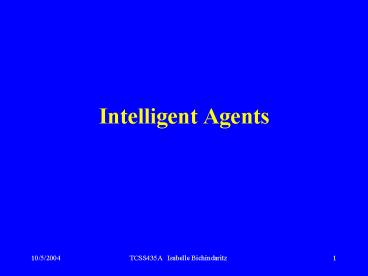Intelligent Agents - PowerPoint PPT Presentation
1 / 36
Title:
Intelligent Agents
Description:
An agent is anything that can be viewed as perceiving its ... scans Internet news sources to pick interesting items for its customers. Performance measures? ... – PowerPoint PPT presentation
Number of Views:41
Avg rating:3.0/5.0
Title: Intelligent Agents
1
Intelligent Agents
2
Learning Objectives
- Agents and environment
- Rationality
- PEAS (Performance measure, Environment,
Actuators, Sensors) - Environment types
- Agent types
3
Acknowledgments
- These slides have been adapted from Stuart
Russell and Peter Norvig
4
Agents and Environments
- Russell and NorvigAn agent is anything that
can be viewed as perceiving its environment
through sensors and acting upon them through
actuators.
5
Agents and Environments
- Ferber
- An agent is a physical or virtual entity
- Which is capable of acting in an environment,
- Which can communicate directly with other agents,
- Which is driven by a set of tendencies,
- Which possesses resources of its own,
- Which is capable of perceiving its environment,
- Which has only a partial representation of this
environment, - Which possesses skills and can offer services,
- Which may be able to reproduce itself,
- Whose behavior tends towards satisfying its
objectives, taking account of the resources and
skills available to it and depending on its
perception, its representations and the
communications it receives.
6
Agents and Environments
- Agents include humans, robots, softbots,
thermostats, etc. - The agent function maps from percept histories to
actions - The agent program runs on the physical
architecture to produce
7
Agents and Environments
- Vacuum-Cleaner World
8
Agents and Environments
- Vacuum-Cleaner World
9
Agents and Environments
- Vacuum-Cleaner World
- What is the right function?Can it be implemented
in a small agent program?
10
Rationality
- A rational agent does the right thing.
- What is the right thing?
- One possibility
- The action that will maximize success.
- But what is success?
- The action that maximizes the agents goals.
- Use a performance measure to evaluate agents
success.
11
Rationality
- Fixed performance measure evaluates the
environment sequence - One point per square cleaned up in time T
- One point per clean square per time step, minus
one per move? - Penalize for more than k dirty squares?
- A rational agent chooses whichever action
maximizes the expected value of the performance
measure given the percept sequence to date.
12
Rationality
- Rational agent definitionFor each possible
percept sequence, a rational agent should select
an action that is expected to maximize its
performance measure, given the evidence provided
by the percept sequence and whatever built-in
knowledge the agent has.
13
Rationality
- Rationality is not
- Omniscience
- Clairvoyance
- Success
- Rationality implies
- Exploration
- Learning
- Autonomy
14
PEAS
- Task environments are the problems to which
rational agents are the solutions. - PEAS Performance, Environment, Actuators,
Sensors. - Task environment needs to be defined first.
- Example the task of designing an automated taxi.
15
PEAS
- Performance measure?
- Environment?
- Actuators?
- Sensors?
16
PEAS
- Medical diagnosis system
- Satellite image analysis system
- Part-picking robot
- Refinery controller
- Interactive English tutor
17
PEAS
- Softbots (software robots, software agents) are
purely software agents. - Example Internet shopping agentscans Internet
news sources to pick interesting items for its
customers - Performance measures?
- Environment?
- Actuators?
- Sensors?
18
Environment Types
- Categorization of environment tasks
- Fully/partially observableextent to which an
agents sensors give it access to the complete
state of the environment - Deterministic/stochasticextent to which the next
state of the environment is determined by the
current state
19
Environment Types
- Categorization of environment tasks
- Episodic/sequentialextent to which the agents
experience is divided into atomic episodes - Static/dynamicextent to which the environment
can change while the agent is deliberating
20
Environment Types
- Categorization of environment tasks
- Discrete/continuousextent to which state of the
environment, time, percepts and actions of the
agent are expressed as a set of discrete values - Single agent/multiagent
21
Environment Types
22
Environment Types
23
Environment Types
24
Environment Types
25
Environment Types
26
Environment Types
27
Environment Types
28
Environment Types
- The environment type largely determines the agent
design - The real world is (of course) partially
observable, stochastic, sequentiql, dynamic,
continuous, multi-agent
29
Agent Types
- Four basic types in order of increasing
generality - Simple reflex agents
- Reflex agents with state
- Goal-based agents
- Utility-based agents
- All these can be turned into learning agents.
30
Agent Types
- Agent architecture program
- Simple reflex agent
- Reflex agent with state
- Goal-based agent
- Utility-based agent
- Learning agent
31
Agent Types
- Simple reflex agent
32
Agent Types
- Reflex agent with state
33
Agent Types
- Goal-based agent
34
Agent Types
- Utility-l-based agent
35
Agent Types
- Learning agent
36
Source Code
- Source code for the book is on the book Web-site
- In Lisp, Python
- Partially in C and Java







![ARTIFICIAL INTELLIGENCE [INTELLIGENT AGENTS PARADIGM] PowerPoint PPT Presentation](https://s3.amazonaws.com/images.powershow.com/8134330.th0.jpg?_=20160919108)
![ARTIFICIAL INTELLIGENCE [INTELLIGENT AGENTS PARADIGM] PowerPoint PPT Presentation](https://s3.amazonaws.com/images.powershow.com/5822646.th0.jpg?_=20141212109)






















